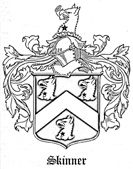Skinner
Name and Crest

SKINNER FAMILY NAME AND COAT OF ARMS
"Skinner" was the term used by the English for the busy tradesman
who dealt in the animal furs which were used primarily for trimming and lining
clothing. This trade was usually found only in large towns and cities, since
people in the small villages and rural areas generally made their own clothing.
The word "skinner" has at least two sources. The Old Norse word for this occupation
was "skinnari", and the Anglo-Saxon term for skin was "scinn". In medieval records
this occupation can be found in the form of "le skynner" or "le schimner", written
after the christian name of the individual being identified. Many tradesmen
were identified in this fashion, and the many modern Smiths, Millers, and Masons
testify to the fact that they often found it desirable to adopt their occupational
titles as surnames. In some cases the "skinner" may have been merely an assistant
of the "tanner" who prepared hides for leather goods. Family names of occupation
origin, like Skinner, form the third largest class of the four classes of name
origin. These classes in order of size are, place names (Atwood, Brooks), relationship
(Williamson, Jackson), occupation (Clark, Mason), and nicknames (Armstrong,
Whitehead). Because of the evolutionary nature of name development, it is virtually
impossible to pinpoint the exact date of the formation of any new name. Skinner,
of course, is no exception. However, some of the ancient records of the English
nation, including the famous Hundred Rolls, give evidence of early forms of
the name and show usage as early as 1273. The names listed below are excerpts
from these records.
Henry le Skyniar' - County Oxfordshire - Hundred Rolls, 1273
Robert le Skynnere - Writs of Parliament, 1302
Robert le Skynnar - County Somersetshire - Kirby's Quest, 1327-1377
Johannes Sckynner - Yorkshire Poll Tax, 1379
The surname Skinner is most abundant in the English counties
of Kent and Devonshire and is also found to a lesser extent in Norfolk, Cornwall,
Sussex, Worcestershire, Surrey, and Lincolnshire. By the time of the first census
in America in 1790, many Skinner families had settled in this country. The average
Skinner household had 5.5 members and census records indicate that there were
more Skinner heads-of- family in Connecticut, New York, and Massachusetts than
in any other part of America. Official United States records compiled in that
in that year Skinner was the 534th most frequently name in the nation. Today
there are approximately 52,840 adults named Skinner.
Heraldry,or the study of armorial bearings, is an adjunct to the study of
family hitory. Coat armor, it is important to note, was completely unknown
in europe before the twelfth century, and did not appear in about 1250. Its
sudden rise has been ascribed to several , including the First Crusade (1097),
the advent of body armor and the growing use of seals on personal documents.
In any case, the early development of the use of heraldic devices followed
closely upon the need for better identification, and the trend became widespread.
First embellished on shields and other pieces of armor, the imaginative, elaborate
heraldic designs soon were transferred to surcoats and trappings, and even
private possessions. These early insignia, including bends (diagonal stripes),
fesses (horizontal stripes), crosses, were chosen because they were conspicuous,
even in the chaos of bloody battle. For the same reason bright colors were
used. Charges, or the representations of animals and natural objects, did
not become popular until the second half of the twelfth century, when, as
stated above the use of surnames was revived.
Burke's General Armory lists ten different coats of arms for
the Skinner family Following are descriptions of three of them.
ARMS Sable, a chevron or between three griffins' heads erased argent, a mullet
for difference. CREST: A griffin's head erased argent holding in the beak
a hand couped gules on a breast a mullet for difference. (Arms: On a black
field a gold chevron between three silver griffins' heads [balf eagle and
balf lion] torn from the body and a five-pointed star on the chevron for difference.
Crest. A silver griffin's head erased holding in its beak a red hand and on
the breast a five- pointed star for difference.)
ARMS Argent, a chief azure semee-de-lis of the first. CREST:
Out of a ducal coronet or, a demi talbot gules collared and lined argent. (Arms:
On a silver field with the top third part of the field blue and silver fleur-de-lis
strewd all over it. Crest. Out of a gold crown the head of a red hunting dog
with a silver collar and chain.)
ARMS: Sable,
three griffins' heads erased argent. CREST: A griffin's head erased argent
in the beak
a dexter hand couped at the wrist gules. (Arms:
On a black field, three silver griffin's heads [half eagle and half lion]
forcibly lorn from the body. Crest" A silver girffin's head torn from the
body and in beak a red right hand cut at the wrist.)